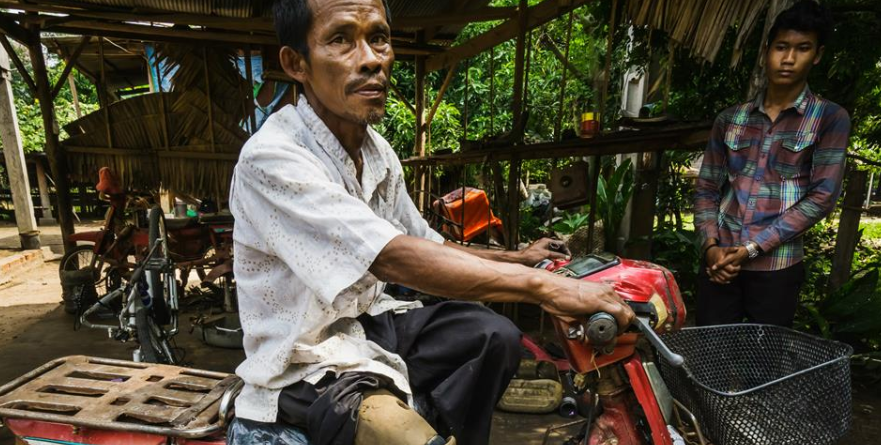International Day of Persons with Disabilities 2021 — Dec, 3rd
COVID-19 has resulted in further disadvantage and increased vulnerability for many persons with disabilities due to barriers in the health and social sectors, including discriminatory attitudes and inaccessible infrastructure.
WHO
November, 2021
December 3 is International Day of Persons with Disabilities (IDPD), and on this Day WHO joins other partners around the world to celebrate a day for all.

More than 1 billion people experience disability, and this figure is predicted to rise, due in part to population ageing and an increase in the prevalence of noncommunicable diseases.
Despite this, few countries have adequate mechanisms in place to respond fully to the health priorities and requirements of persons with disabilities.
While disability correlates with disadvantage, not all people with disabilities are equally disadvantaged.
Much depends on the context in which they live, and whether they have equal access to health, education and employment, among others.
As governments and the international community continue to battle the COVID-19 pandemic, and chart a course forward, it is essential that disability inclusion is central to health system planning, development, and decision making.
Strong, effective health systems support robust health emergencies management.
WHO is committed to supporting Member States and development partners to fulfil their commitment to leave no one behind, by addressing disability inclusion in the health sector, including as part of our efforts to end the COVID-19 pandemic.
Key messages:
- Many of us will experience disability in our lifetime, particularly as we grow older
- WHO commits to supporting countries to realize a world where health systems are inclusive and persons with disabilities can attain their highest possible standard of health.
- COVID-19 has resulted in further disadvantage and increased vulnerability for many persons with disabilities due to barriers in the health and social sectors, including discriminatory attitudes and inaccessible infrastructure.
- Building back better requires persons with disabilities to be central to health sector decision making, to ensure barriers are addressed in an inclusive and timely way.
- Disability inclusion in the health sector is not only the right thing to do, but also the smart thing to do, as it directly contributes to the achievement of broader global and national health priorities.
Originally published at https://www.who.int on December 30, 2021.

Disability and health
WHO
24 November 2021
Key facts
- Over 1 billion people live with some form of disability.
- The number of people with disability are dramatically increasing. This is due to demographic trends and increases in chronic health conditions, among other causes.
- Almost everyone is likely to experience some form of disability — temporary or permanent — at some point in life.
- People with disability are disproportionately affected during the COVID-19 pandemic.
- When people with disability access health care, they often experience stigma and discrimination, and receive poor quality services.
- There is an urgent need to scale up disability inclusion in all levels of the health system, particularly primary health care.
Overview
Disability refers to the interaction between individuals with a health condition (e.g., cerebral palsy, Down syndrome and depression) and personal and environmental factors (e.g., negative attitudes, inaccessible transportation and public buildings, and limited social supports).
Over 1 billion people are estimated to experience disability.
This corresponds to about 15% of the world’s population, with up to 190 million (3.8%) people aged 15 years and older having significant difficulties in functioning, often requiring health care services.
The number of people experiencing disability is increasing due to a rise in chronic health conditions and population ageing.
Disability is a human rights issue, with people with disability being subject to multiple violations of their rights, including acts of violence, abuse, prejudice and disrespect because of their disability, which intersects with other forms of discrimination based on age and gender, among other factors.
People with disability also face barriers, stigmatization and discrimination when accessing health and health-related services and strategies.
Disability is a development priority because of its higher prevalence in lower-income countries and because disability and poverty reinforce and perpetuate one another.
Disability is extremely diverse.
While some health conditions associated with disability result in poor health and extensive health care needs, others do not.
However, all people with disability have the same general health care needs as everyone else, and therefore need access to mainstream health care services.
Article 25 of the UN Convention on the Rights of Persons with Disabilities (CRPD) reinforces the right of persons with disability to attain the highest standard of health, without discrimination.
However, the reality is that few countries provide adequate quality services for people with disability.
Barriers to healthcare
People with disability encounter a range of barriers when they attempt to access health care including:
Attitudinal barriers
- People with disability commonly report experiences of prejudice, stigma and discrimination by health service providers and other staff at health facilities.
- Many service providers have limited knowledge and understanding of the rights of people with disability and their health needs and have inadequate training and professional development about disability.
- Many health services do not have policies in place to accommodate the needs of people with disability. Such policies could include allowing longer and flexible appointment times, providing outreach services and reducing costs for people with disability.
- Women with disability face particular barriers to sexual and reproductive health services and information. Health workers often make the inaccurate assumption that women with disability are asexual or are unfit to be mothers.
- People with disability are rarely asked for their opinion or involved in decision-making about the provision of health services to people with disability.
Physical barriers
- Health services and activities are often located far away from where most people live or in an area not serviced by accessible transport options.
- Stairs at the entrance to buildings or services and activities located on floors which do not elevator access are inaccessible.
- Inaccessible toilets, passages, doorways and rooms that do not accommodate wheelchair users, or are difficult to navigate for people with mobility impairments, are common.
- Fixed-height furniture, including examination beds and chairs, can be difficult for people with disability to use.
- Health facilities and other venues for activities are often poorly lit, do not have clear signage, or are laid out in a confusing way that makes it hard for people to find their way around.
Communication barriers
- A key barrier to health services for people who have a hearing impairment is the limited availability of written material or sign language interpreters at health services.
- Health information or prescriptions may not be provided in accessible formats, including Braille or large print, which presents a barrier for people with vision impairment.
- Health information may be presented in complicated ways or use a lot of jargon. Making health information available in easy-to-follow formats — including plain language and pictures or other visual cues — can make it easier for people with cognitive impairments to follow.
Financial barriers
- Over half of all people with disability in low-income countries cannot afford proper health care.
- Many people with disability also report being unable to afford the costs associated with travelling to a health service and paying for medicine, let alone the cost of paying to see a health service provider.
Disability inclusion in the health sector
Disability is often not perceived as a health issue.
Therefore, action is not taken towards disability inclusion in the health sector, which is also often overlooked in national disability strategies and action plans to implement and monitor the CRPD.
Attaining the highest possible standard of health and well-being for all will only be possible if governments understand the need for a paradigm shift, recognizing that the global health goals can only be achieved when disability inclusion is intrinsic to health sector priorities, including:
- universal health coverage without financial hardship
- protection during health emergencies
- access to cross-sectorial public health interventions, such as water, sanitation and hygiene services.
Disability inclusion is critical to achieving universal health coverage without financial hardship, because persons with disabilities are:
- three times more likely to be denied health care
- four times more likely to be treated badly in the health care system
- 50% more likely to suffer catastrophic health expenditure.
Disability inclusion is critical to achieving better protection from health emergencies, because persons with disabilities are disproportionately affected by COVID-19, including:
- directly due to increased risk of infection and barriers in accessing healthcare
- indirectly due to restrictions to reduce spread of virus (e.g., disruptions in support services).
Disability inclusion is critical to achieving better health and well-being, because persons with disabilities are:
- 4–10 times more likely to experience violence
- at higher risk of nonfatal injury from road traffic crashes.
Children with disabilities are:
- three times more likely to experience sexual abuse
- two times more likely to be malnourished.
WHO response
To improve access to and coverage of health services for people with disability, WHO:
- guides and supports Member States to increase awareness of disability issues, and promotes the inclusion of disability as a component in national and sub-national health programmes;
- facilitates collection and dissemination of disability-related data and information;
- develops normative tools, including guidelines to strengthen disability inclusion within health care services;
- builds capacity among health policymakers and service providers;
- promotes strategies to ensure that people with disability are knowledgeable about their own health conditions, and that health care personnel support and protect the rights and dignity of persons with disability;
- contributes to the United Nations Disability Inclusion Strategy (UNDIS) to promote “sustainable and transformative progress on disability inclusion through all pillars of work of the United Nations”; and
- provides Member States and development partners with updated evidence, analysis and recommendations related to disability inclusion in the health sector.
Originally published atDisability and health
Disability refers to the interaction between individuals with a health condition (e.g., cerebral palsy, Down syndrome…www.who.int
Despite this, few countries have adequate mechanisms in place to respond fully to the health priorities and requirements of persons with disabilities.
While disability correlates with disadvantage, not all people with disabilities are equally disadvantaged.
Much depends on the context in which they live, and whether they have equal access to health, education and employment, among others.
As governments and the international community continue to battle the COVID-19 pandemic, and chart a course forward, it is essential that disability inclusion is central to health system planning, development, and decision making.
Strong, effective health systems support robust health emergencies management.
WHO is committed to supporting Member States and development partners to fulfil their commitment to leave no one behind, by addressing disability inclusion in the health sector, including as part of our efforts to end the COVID-19 pandemic.
Key messages:
- Many of us will experience disability in our lifetime, particularly as we grow older
- WHO commits to supporting countries to realize a world where health systems are inclusive and persons with disabilities can attain their highest possible standard of health.
- COVID-19 has resulted in further disadvantage and increased vulnerability for many persons with disabilities due to barriers in the health and social sectors, including discriminatory attitudes and inaccessible infrastructure.
- Building back better requires persons with disabilities to be central to health sector decision making, to ensure barriers are addressed in an inclusive and timely way.
- Disability inclusion in the health sector is not only the right thing to do, but also the smart thing to do, as it directly contributes to the achievement of broader global and national health priorities.
Originally published at https://www.who.int on December 30, 2021.












